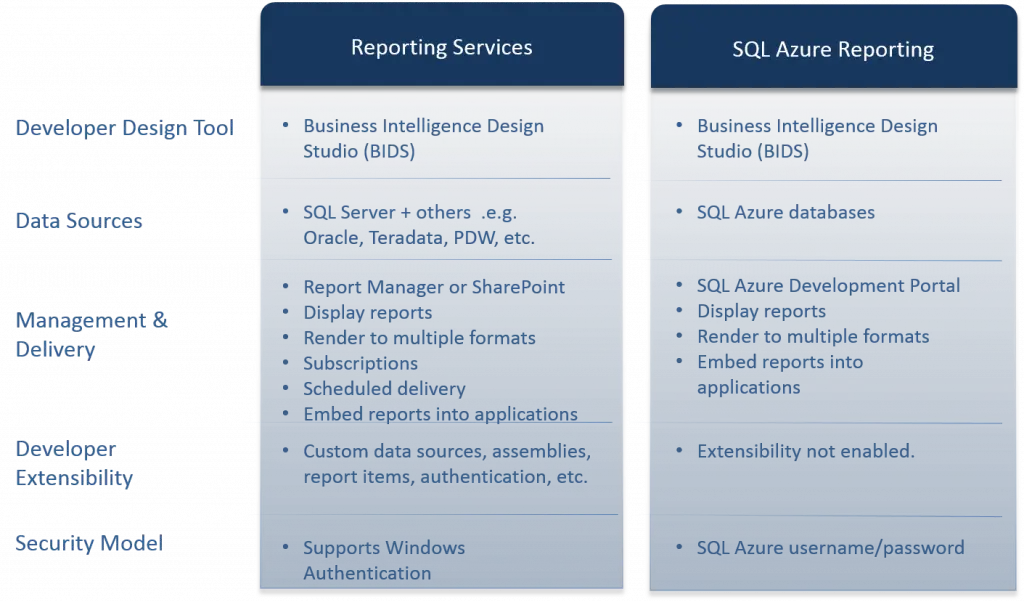
Windows Azure SQL Reporting is a cloud-based reporting service for the Windows Azure Platform built on SQL Server Reporting Services technologies. SQL Azure Reporting provides many benefits, including rapid provisioning, cost-effective scalability, high availability, reduced management overhead, and secure access for viewing and managing reports.
By using SQL Reporting, you can easily deploy reporting solutions to the cloud, and take advantage of a distributed data center that provides enterprise-class availability, scalability, and security with the benefits of built-in data protection and self-healing. You can publish, view, and manage operational reports that display data from Azure SQL Database data sources.
Developers can use SQL Reporting to add a rich reporting experience to their applications running on-premise or in the cloud. They can author reports using familiar SQL Server Reporting Services tools and then use these reports in their applications.
Microsoft SQL Azure Database: Relational Database as a Service
Self-managed
• Easy provisioning and deployment
• Auto High availability and fault tolerant
• Self-managing and self-healing
Elastic Scale
• Database as a utility with pay as you grow scaling
• Rely on Business-ready SLAs
• Enable multi-tenant solutions
• Manage multiple servers
Developer Agility
• Build cloud-based database solutions on a familiar relational model
• Build on existing developer skills and familiar Transact-SQL syntax
• Explore new data application patterns
SQL Azure Reporting
Developer Agility & Choice
• Build reports using familiar design tools
• Publish reports to the cloud or embed directly within applications
• Use consistent API’s to view, execute and manage reports
Extended Reach & Accessibility
• Secure and reliable access to reports
• Access reports within an application or via a web browser
• Render and export to the format desired
Elastic Scale & Reliability
• Off-premises reporting infrastructure lowers TCO
• Highly available Windows Azure environment
• Scales to meet the demands of the business as needed
Core Scenarios
• Operational reports over SQL Azure data: Customers can report over their SQL Azure data, not necessarily with the intent to embed them into an application.
• Embedding reports into my Windows or Azure application: Developers can use same patterns and tools they use today to embed reports into their applications in connected mode against Azure RS service.
SQL Azure Reporting & SQL Server Reporting Services

SQL Azure Reporting Benefits
- Rich Reporting Experience: Like the on premises version of Reporting Services, SQL Azure Reporting makes it easy to host highly visual, interactive reports that use a variety of layouts including tabular, matrix, chart, and free-form and provide a rich reporting experience for your Azure SQL Database data in reports hosted in the cloud. These reports can be rendered in a variety of formats like PDF, MHTML, EXCEL, XML, CSV, TIFF, and, WORD.
- Manageability: In SQL Reporting, common administrative tasks such as managing report server content, configuring shared data sources, creating users and setting permissions can be performed programmatically by using report server Web service API, or graphically by using the Azure Management Portal user interface for SQL Reporting.
- Familiar Development Tools: Whether you create reports in Report Designer or in Visual Studio as part of a Report Viewer application, you can use almost all of the rich features that are available in a Reporting Services report. One notable exception is the use of linked external images. You cannot use linked content in a report hosted in SQL Reporting.
- High Availability and Scalability: By using SQL Reporting, you can create or delete your report servers in minutes, as needed by your business cycle. To further support scalability, you can choose from one of the globally distributed data centers.
- Cost-effectiveness: Like other services on the Azure Platform, SQL Reporting is designed to support elastic scale. You only pay for what you use and can add or release excess capacity, depending on your needs. Based on your day-to-day, month-to-month, or seasonal requirements, you can easily and quickly add subscriptions and report servers to extend the capacity of your SQL Reporting environment and delete subscriptions and servers to decrease it.






